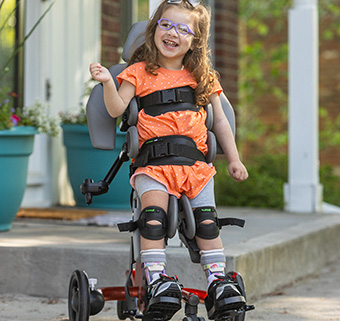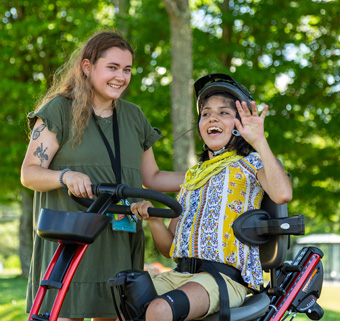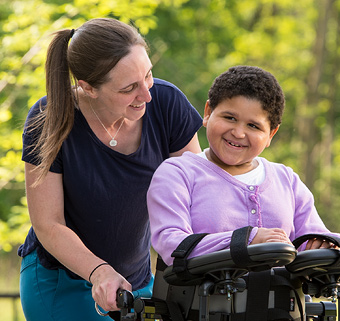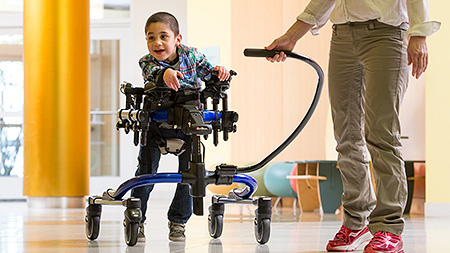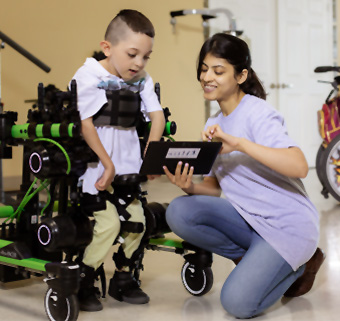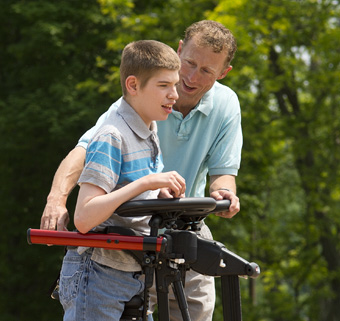Evidence Update: Overground Supported Stepping in Individuals with Non-Ambulant Cerebral Palsy
| October 2023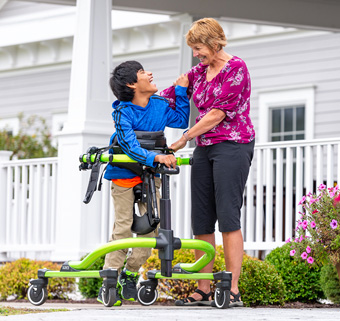 Providing supported gait opportunities for individuals with multiple disabilities is a foundational therapy intervention. For those diagnosed with cerebral palsy (CP), assessing motor function and the use of adaptive mobility and positioning devices helps determine their level on the Gross Motor Function Classification Scale (GMFCS). Individuals with CP in GMFCS levels of IV and V are more severely involved and cannot walk independently; their lives are largely sedentary. They require extensive adaptive support for all mobility and positioning including gait trainers, standing devices and wheelchairs. Progressing musculoskeletal impairments such as contractures and windswept deformities are common in this group, along with pain, declining cardiovascular fitness and limitations in function.
Providing supported gait opportunities for individuals with multiple disabilities is a foundational therapy intervention. For those diagnosed with cerebral palsy (CP), assessing motor function and the use of adaptive mobility and positioning devices helps determine their level on the Gross Motor Function Classification Scale (GMFCS). Individuals with CP in GMFCS levels of IV and V are more severely involved and cannot walk independently; their lives are largely sedentary. They require extensive adaptive support for all mobility and positioning including gait trainers, standing devices and wheelchairs. Progressing musculoskeletal impairments such as contractures and windswept deformities are common in this group, along with pain, declining cardiovascular fitness and limitations in function.
For children in this group, targeted opportunities to be upright and actively use their muscles in functional tasks improves quality of life, benefits social interactions and offers necessary changes in position to reduce secondary impairments later on.
In tandem with a previous systematic review looking at supported stepping devices outcomes in children with multiple disabilities, another newly published scoping systematic review highlights the use of these devices in children, adolescents and adults with non-ambulant cerebral palsy. Some of the findings are note-worthy in a population and topic that is otherwise less researched.
Specifically, through expanding the scope of their search to include case studies, descriptive and grey literature, the researchers documented the successful use of supported stepping devices in over 700 individuals with non-ambulant CP. In combination with reports from families and therapists surrounding the benefits of gait training, this finding suggests the current provision and use of gait trainers in this population continues to be best practice.
Supported Stepping Devices and ICF Outcomes
Using the ICF and F-Words Model for Childhood Disability, this review reported the benefits of supported stepping devices across the domains of body function and structures (fitness), activity (function) and participation (friendships) from as early as nine months on into adulthood. Although some therapists prescribe gait trainers for improving mobility, the authors note that individuals with non-ambulant CP typically use powered wheelchairs for this functional mobility. Supported stepping devices are more appropriate to improve fitness and participation. Parents of children in GMFCS levels IV and V also tend to specify gait training goals focusing on physical activity, increasing independence and improving participation in activities of daily living.
The authors additionally reported on the utilization of supported stepping devices according to age, GMFCS level and outcome. The findings were diverse, making it hard to identify any clear trend. Thus, the prescription and choice of gait trainer continues to be highly individualized taking into account funding, availability, transfer capabilities, environment and postural support features.
This scoping review provides a comprehensive look at the literature pertaining to supported stepping in individuals with non-ambulant cerebral palsy. Clearly there are remaining research questions to be pursued in the future. Regardless, it still stands that providing individuals with CP in GMFCS levels IV and V opportunities to be upright and weight-bearing improves quality of life through the reduction of sedentary behavior and scope for increased participation.
Reference
Livingstone RW, Paleg GS. Use of overground supported-stepping devices for non-ambulant children, adolescents, and adults with cerebral palsy: A scoping review. Disabilities. 2023; 3(2):165-195. https://doi.org/10.3390/disabilities3020012
